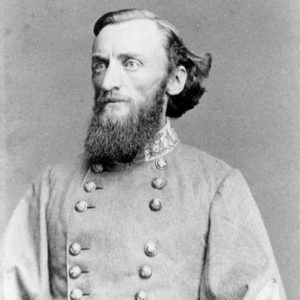calsfoundation@cals.org
Skirmish at Batesville (February 4, 1863)
| Location: | Independence County |
| Campaign: | None |
| Date: | February 4, 1863 |
| Principal Commanders: | Colonel George Waring (US); General John S. Marmaduke, Colonel Joseph O. Shelby (CS) |
| Forces Engaged: | Fourth Missouri Cavalry (US); Unidentified units (CS) |
| Estimated Casualties: | Exact numbers unreported for either side |
| Result: | Union victory |
On December 31, 1862, General John S. Marmaduke and 8,000 cavalry launched a raid into Missouri from near Lewisburg (Conway County) in the Arkansas River Valley, only to meet defeat at Hartsville, Missouri. The Confederate retreat back into Arkansas took them to Independence County, retracing the steps of Brigadier General Samuel Curtis’s army eight months earlier. Gen. Marmaduke established his troops at Oil Trough (Independence County), and Colonel Joseph O. Shelby set up camp at the farm of Franklin Desha. Both bivouacs were south of the White River, but Marmaduke’s headquarters were at the Cox house in Batesville (Independence County).
Union forces in Missouri gathered at West Plains, Missouri, on January 29, 1863. The next day, Brigadier General John Davidson received a message from Gen. Curtis giving permission for a cavalry raid on the Confederates thought to be in or near Batesville. The task was given to Colonel George Waring, commander of the Fourth Missouri Cavalry. He did not expect his 600 men to escape detection for long, but a scout who raced south to warn Marmaduke of the Federal advance was disbelieved. Contact between the forces occurred twelve miles north of town on the afternoon of February 4, and the Union advance chased the small scout back into Batesville.
About to redeploy toward Little Rock (Pulaski County), the Confederates had already moved all but a small detachment south of the White River. As the Union cavalry moved through the deepening snow to Batesville, Waring sent a detachment of thirty men to seize the ferries before the Confederates on the south bank could cross back to defend the town. They succeeded, but only after most of the Confederate soldiers in Batesville had made it across the river. By 10:00 p.m., the town was occupied. Waring chose as his headquarters the Weaver home on Main Street, where he had stayed during the Curtis occupation.
Many of the Union soldiers took advantage of the food and warmth of the houses of Batesville to sleep for a few hours. A significant number of the Federal raiders, though, spent the rest of the night on guard duty and searching the town for supplies.
Waring had learned the size of the units with Marmaduke and Shelby across the river, and he knew he was badly outnumbered. All through the night, the pickets had been on careful watch to detect any attempt to cross the river to attack the Union occupiers. Waring had ordered his troops during the night to build fires over a larger area around Batesville to fool the Confederates into thinking he had a much larger force. It is likely that Waring himself started a rumor among the townspeople that his force was only a detachment of a large army coming behind him, hoping to keep off a counterattack.
The Union troops wasted no time packing and preparing to move at dawn; as Waring reported, “We levied such contributions of supplies as were necessary for our return march, and, in order that the return might not look like a retreat, we loaded two wagons with hogsheads of sugar, which would be welcome in Davidson’s commissariat.” Local resident Emily Weaver noted, “Towards day-break, the whole command moved swiftly north, and a few hours later, Gen. Shelby crossed the river with about three thousand men, and followed them a short distance.”
Waring led his men, their prisoners, and their supplies as rapidly as possible through the snow back north. One historian summarized the end of the story succinctly: “The command then marched to Evening Shade, Arkansas, twenty-five miles north of Batesville, where Waring paroled and released most of his badly frostbitten prisoners.”
After the troops returned to West Plains, the public press hailed the romantic adventure. The results were some casualties on both sides, the expenditure of great effort, and endurance of acute cold and pain. A few wagon-loads of forage and goods went north with the troops, but that hardly seemed enough to justify the danger. According to one source, “Waring himself believed that the cavalry’s operations had done little more than weary the men,” and Colonel Isaac H. Elliott of the Thirty-third Illinois Infantry said that “if the campaign had any purpose, no one knew it.” For Waring, the raid on Batesville was just another adventure. As he said in introducing his account, “Now and then we made a little scout that varied our otherwise dull lives.”
For additional information:
Bradbury, John F., Jr. “‘This War is Managed Mighty Strange’: The Army of Southeastern Missouri, 1862–1863.” Missouri Historical Review 89 (October 1994): 28–47.
Lankford, George E. “The Waring Raid.” Independence County Chronicle 54 (January 2013): 15–24.
Reed, Emily S. “Personal Recollections of 1863.” In Confederate Women of Arkansas in the Civil War, 1861–65. Little Rock: H. G. Pugh Printing Company, 1907. Online at http://openlibrary.org/books/OL23290382M/Confederate_women_of_Arkansas_in_the_civil_war_1861-65. (accessed January 20, 2022).
Waring, George E., Jr. Whip and Spur. Boston: Doubleday and McClure, 1897.
George E. Lankford
Batesville, Arkansas
 Civil War Timeline
Civil War Timeline Military
Military ACWSC Logo
ACWSC Logo  John Marmaduke
John Marmaduke 




Comments
No comments on this entry yet.